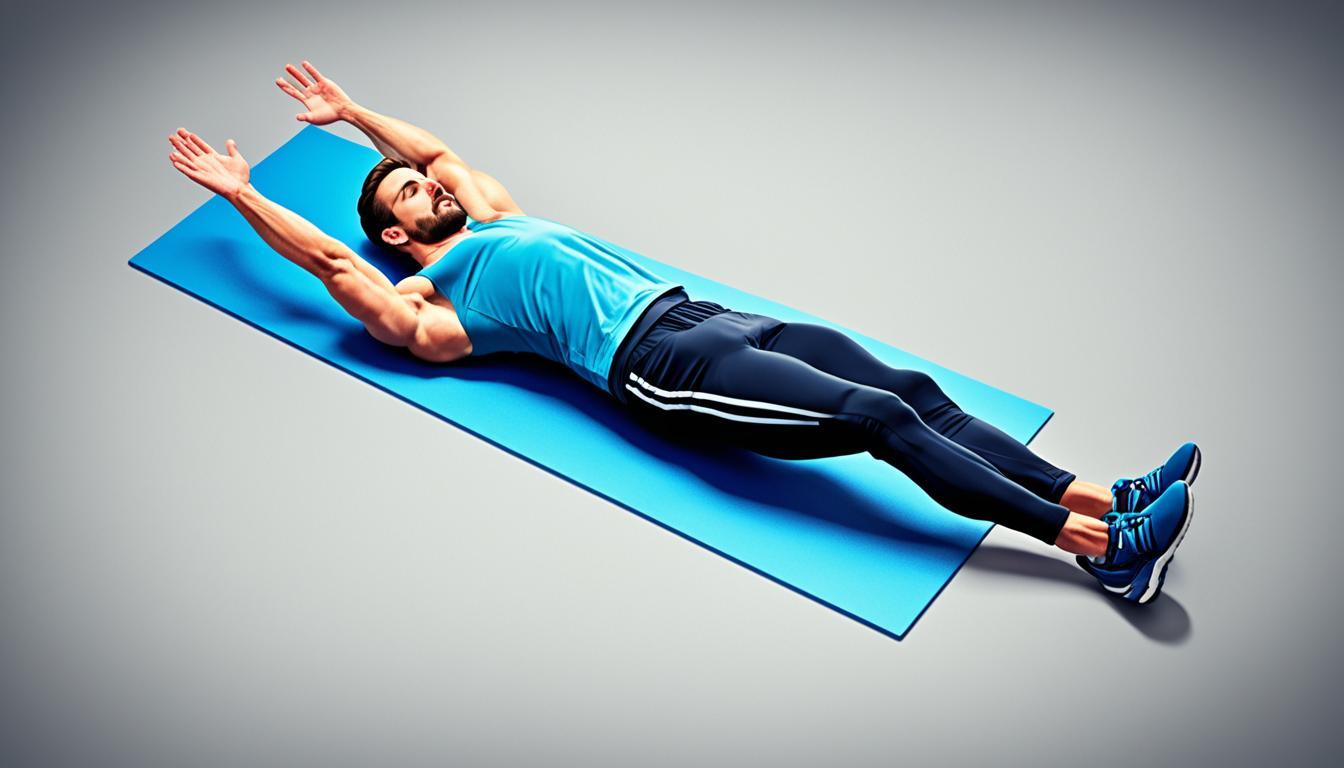Isometric ab exercises are a powerful tool for strengthening your core and improving overall body strength and stability. These exercises provide a unique challenge that helps to prevent workout plateaus and activate postural muscles essential for everyday movements and sports. By incorporating isometric ab exercises into your routine, you can achieve a strong and toned midsection.
Isometric ab exercises work the core muscles in a different way than traditional core workouts. Instead of dynamic movements, isometric exercises involve holding positions and contracting the muscles without any joint movement. This static contraction emphasizes core stability and endurance, ultimately leading to a stronger core foundation.
Key Takeaways:
- Isometric ab exercises are effective for building core strength and stability.
- These exercises work the core muscles in a different way and provide new challenges.
- Incorporating isometric ab exercises into your routine can help prevent workout plateaus.
- Isometric ab exercises activate postural muscles important for everyday movements and sports.
- Isometric ab exercises contribute to a strong and toned midsection.
Plank Variations for Isometric Ab Exercises.
Plank exercises are a foundational isometric ab exercise that can be modified to target different areas of the core. By incorporating variations of the plank into your workout routine, you can challenge your core muscles in new ways and enhance your strength and stability.
Forearm Plank
The forearm plank is a popular variation that effectively engages the core. To perform a forearm plank:
- Start by placing your forearms on the ground, with your elbows directly under your shoulders.
- Position yourself on the balls of your feet, keeping your body in a straight line from head to toe.
- Engage your core by contracting your abdominal muscles.
- Hold this position for a specific duration, gradually increasing the time as you build strength.
High Plank
The high plank is similar to the forearm plank but involves supporting your body with your hands instead of your forearms. Here’s how to perform a high plank:
- Start in a push-up position with your hands directly under your shoulders, arms extended.
- Balance on the balls of your feet, keeping your body in a straight line.
- Activate your core by tightening your abdominal muscles.
- Maintain this position for a specific duration, gradually increasing the time as you progress.
Side Plank
The side plank targets the oblique muscles, which play a crucial role in stabilizing the core. To perform a side plank:
- Lie on your side with your legs stacked or one leg lifted for an added challenge.
- Position your forearm or hand directly under your shoulder.
- Raise your body into a straight line, keeping your core engaged.
- Hold this position for a specific duration, then switch sides to work both oblique muscles equally.
These plank variations are just a few examples of how you can add variety to your isometric ab exercises. By incorporating these variations into your routine, you can target different areas of your core and develop greater strength and stability.
| Plank Variation | Primary Muscles Engaged | Level of Difficulty |
|---|---|---|
| Forearm Plank | Rectus abdominis, transverse abdominis, erector spinae, deltoids | Beginner |
| High Plank | Rectus abdominis, transverse abdominis, erector spinae, deltoids | Intermediate |
| Side Plank | Obliques, transverse abdominis, glutes, adductors | Intermediate |
Bear Hold and Hollow Body Hold.
If you’re looking for challenging isometric ab exercises that target your core muscles, look no further than the bear hold and hollow body hold. These exercises will not only help you strengthen your abs, but also improve your core control and stability.
Bear Hold
The bear hold is performed in a tabletop position, with your hands under your shoulders and knees under your hips. To engage your abs, lift your knees a few inches off the floor and squeeze your core. This static hold activates the abdominal muscles and requires you to maintain stability throughout your body.
“The bear hold is a fantastic exercise for developing core strength and stability. By lifting your knees off the ground and engaging your abs, you’re able to challenge your core in a unique way.”
Hollow Body Hold
The hollow body hold is an intense exercise that targets the deep core muscles. To perform this exercise, lie on your back and lift your shoulders and legs off the ground while keeping your lower back pressed into the floor. This position creates a hollow shape with your body, hence the name. The hollow body hold requires strong core control and stability to maintain the position.
By incorporating the bear hold and hollow body hold into your ab workout routine, you’ll be able to strengthen your core and improve your overall stability. These exercises can be modified to suit your fitness level, making them suitable for beginners and advanced exercisers alike.
| Exercise | Benefits |
|---|---|
| Bear Hold |
|
| Hollow Body Hold |
|
Warrior III and Boat Pose.
Warrior III and Boat Pose are two powerful isometric ab exercises that can enhance your core strength and target your glutes. These exercises provide unique challenges and benefits for building a strong and stable core.
Warrior III, also known as Virabhadrasana III in yoga, begins in a standing position with your weight shifted onto one leg. The other leg extends behind you, creating a straight line from head to heel. As you hinge forward from your hips, maintaining proper alignment, your core engages to stabilize the body and maintain balance.
Boat Pose, or Paripurna Navasana, is a classic yoga exercise that challenges your core by lifting your feet off the ground and balancing on your sitting bones. This pose can be modified by straightening your legs or keeping a slight bend, depending on your comfort level and fitness goals.
Both Warrior III and Boat Pose work not only your core muscles but also your glutes, helping to strengthen and tone these important muscle groups. Engaging your core and glutes during these exercises is crucial for maintaining proper alignment and stability.
Remember to focus on your form and alignment while performing Warrior III and Boat Pose to maximize their effectiveness. Keep your core engaged, maintain a steady breath, and listen to your body’s limits to prevent injury.
Now, let’s explore the benefits of these two exercises and learn how to incorporate them into your fitness routine.

Benefits of Warrior III and Boat Pose
- Builds core strength and stability
- Targets the glutes for improved strength and definition
- Improves balance and proprioception
- Enhances coordination and body awareness
- Engages multiple muscle groups for an efficient and effective workout
How to Perform Warrior III
- Start in a standing position with your feet hip-width apart.
- Shift your weight onto your left leg, grounding through your foot.
- Slowly lift your right leg behind you, extending it straight and parallel to the floor.
- Hinge forward from your hips, keeping your back flat and your core engaged.
- Extend your arms forward or reach them alongside your body for balance.
- Hold the pose for 30 seconds to 1 minute, focusing on maintaining stability and alignment.
- Switch sides and repeat the exercise on your right leg.
How to Perform Boat Pose
- Sit on the floor with your knees bent and your feet flat on the ground.
- Lean back slightly, balancing on your sitting bones.
- Lift your feet off the ground, straightening your legs if comfortable or keeping a slight bend.
- Extend your arms parallel to the floor, palms facing down.
- Engage your core, lifting your chest and lengthening your spine.
- Hold the pose for 30 seconds to 1 minute, breathing deeply and maintaining balance.
- Release the pose and repeat for desired repetitions.
Adding Warrior III and Boat Pose to your fitness routine will not only strengthen your core but also challenge your balance and improve overall stability. Remember to start slowly and gradually increase the intensity and duration of these exercises as your strength improves.
Remember, consistency is key when it comes to achieving your fitness goals. Incorporate Warrior III and Boat Pose into your regular workout routine to build core strength, target your glutes, and enhance your overall fitness level.
Isometric Ab Exercises with Equipment.
Adding equipment to your ab workout routine can help take your core strength and stability to the next level. Incorporating equipment-based exercises provides added resistance and challenges your muscles in new ways. Here are three effective isometric ab exercises you can perform using equipment:
Ab Wheel Rollout
The ab wheel rollout is a dynamic exercise that targets your entire core, including your rectus abdominis, obliques, and transverse abdominis. To perform the ab wheel rollout, start on your knees and grip the ab wheel handles with your hands shoulder-width apart. Extend your arms forward while maintaining a strong core and roll the wheel out as far as you can without allowing your lower back to sag. Contract your abs and use your core muscles to pull the wheel back to the starting position. Repeat for the desired number of reps.
Pallof Press
The Pallof press is a functional exercise that strengthens your core and improves stability, particularly in resisting rotation. This exercise can be performed using a cable machine or a resistance band. Begin by standing perpendicular to the anchor point with the resistance band or cable handle at chest height. Hold the handle with both hands and extend your arms in front of you. With your feet shoulder-width apart and your core engaged, press the handle away from your chest, keeping your arms straight. Hold for a few seconds before returning to the starting position. Repeat for the desired number of reps on both sides.
L-Sit
The L-sit is an advanced exercise that targets your core, hip flexors, and upper body strength. Start by sitting on the floor with your legs extended in front of you. Place your hands on the ground next to your hips and lift your butt off the floor. Engage your core muscles and keep your legs straight as you hold this position. Aim to hold the L-sit for as long as possible, gradually increasing your time as you get stronger. If the full L-sit is too challenging, you can modify by bending your knees or using parallettes for additional support.
Remember to warm up before attempting these exercises and listen to your body. Start with lighter resistance or modifications if needed, and gradually increase the intensity as you get stronger. Incorporating these equipment-based isometric ab exercises into your routine can help you build a stronger and more stable core.
Isometric Ab Exercises for Full-Body Strength.
To achieve full-body strength, incorporating isometric ab exercises into your fitness routine is essential. These exercises target not only your core but also your upper body and glutes. By engaging multiple muscle groups simultaneously, you can build strength, stability, and endurance for a more well-rounded physique. Here are three effective isometric ab exercises to incorporate into your workouts:
Dip Hold
The dip hold is an advanced exercise that challenges your core, upper body, and glutes. To perform a dip hold, start by positioning yourself on parallel bars or dip bars, gripping the bars with your hands and lifting your body off the ground. With your arms locked out and your core engaged, hold the top position for a specified amount of time or until failure. This exercise develops strength and stability throughout your entire body.
Handstands
Handstands are a classic isometric exercise that targets your core, shoulders, and arms while requiring stability and balance. You can practice handstands against a wall to build confidence and develop the necessary strength. Begin by placing your hands on the ground shoulder-width apart and kicking your feet up against the wall. As you gain proficiency, you can progress to freestanding handstands. Remember to engage your core to maintain a straight line from head to toe throughout the exercise.
Glute Bridge Hold
The glute bridge hold is a fantastic exercise for activating your glutes and improving overall stability. To perform a glute bridge hold, lie flat on your back with your knees bent and feet hip-width apart. Lift your hips off the ground while maintaining a strong core and glute contraction. Hold this position for a designated amount of time, feeling the burn in your glutes and core. This exercise not only targets your glutes but also engages your core and lower back.
By incorporating dip holds, handstands, and glute bridge holds into your fitness routine, you’ll achieve full-body strength and develop a more robust physique. Remember to maintain proper form and engage your core throughout each exercise for maximum results.
Conclusion.
Isometric exercises are a powerful tool for building core strength, enhancing stability, and improving full-body strength. By focusing on engaging the core muscles in static holds and isometric contractions, these exercises develop control, endurance, and overall core strength.
Incorporating a variety of isometric ab exercises into your routine can help you achieve a more robust and toned midsection. Whether you prefer plank variations, bear holds, warrior III, or equipment-based exercises like ab wheel rollouts, Pallof presses, and L-sits, the key is to prioritize proper form and engaging the target muscles throughout each exercise.
Consistency and dedication are crucial for seeing results. Commit to a regular routine, and over time, you will notice improvements in your core strength and stability. Not only will this enhance your physique, but it will also contribute to improved overall strength and functionality in your daily life and other physical activities.








